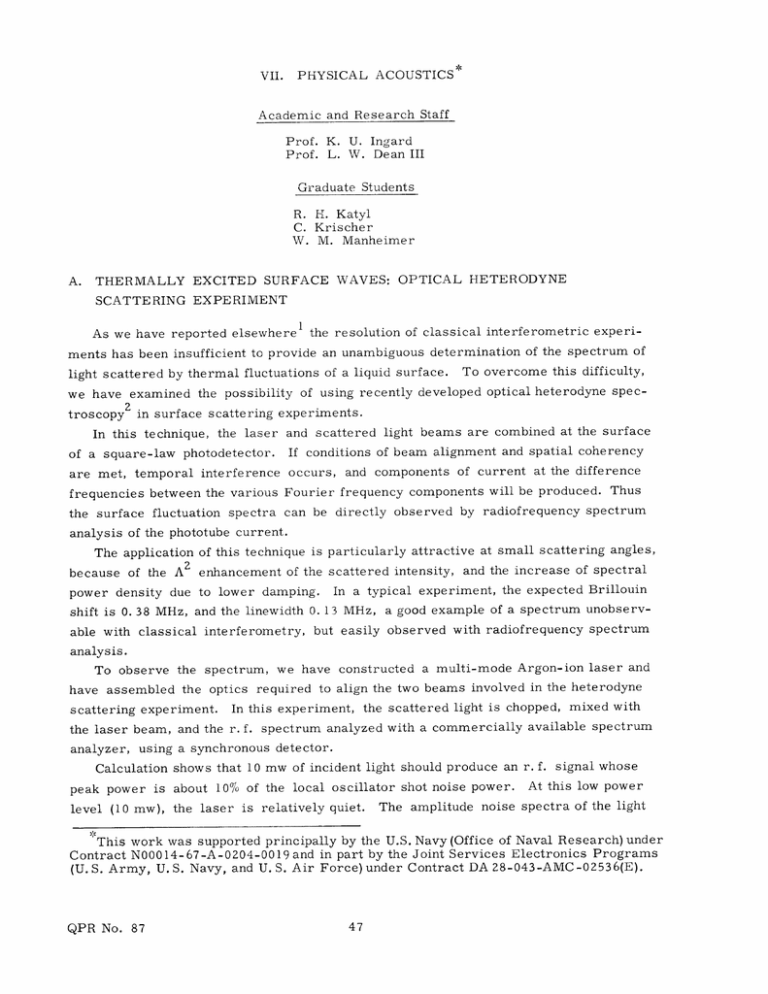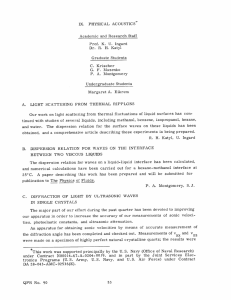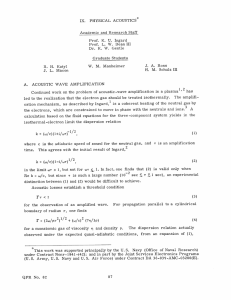VII. PHYSICAL ACOUSTICS* Academic and Research Staff
advertisement

VII. PHYSICAL ACOUSTICS* Academic and Research Staff Prof. K. U. Ingard Prof. L. W. Dean III Graduate Students R. H. Katyl C. Krischer W. M. Manheimer A. THERMALLY EXCITED SURFACE WAVES: OPTICAL HETERODYNE SCATTERING EXPERIMENT As we have reported elsewherel the resolution of classical interferometric experi- ments has been insufficient to provide an unambiguous determination of the spectrum of light scattered by thermal fluctuations of a liquid surface. To overcome this difficulty, we have examined the possibility of using recently developed optical heterodyne spectroscopy2 in surface scattering experiments. In this technique, the laser and scattered light beams are combined at the surface of a square-law photodetector. If conditions of beam alignment and spatial coherency are met, temporal interference occurs, and components of current at the difference frequencies between the various Fourier frequency components will be produced. Thus the surface fluctuation spectra can be directly observed by radiofrequency spectrum analysis of the phototube current. The application of this technique is particularly attractive at small scattering angles, because of the A2 enhancement of the scattered intensity, and the increase of spectral power density due to lower damping. In a typical experiment, the expected Brillouin shift is 0. 38 MHz, and the linewidth 0. 13 MHz, a good example of a spectrum unobserv- able with classical interferometry, but easily observed with radiofrequency spectrum analysis. To observe the spectrum, we have constructed a multi-mode Argon-ion laser and have assembled the optics required to align the two beams involved in the heterodyne scattering experiment. the scattered light is chopped, mixed with In this experiment, the laser beam, and the r. f. spectrum analyzed with a commercially available spectrum analyzer, using a synchronous detector. Calculation shows that 10 mw of incident light should produce an r. f. signal whose peak power is about 10% of the local oscillator shot noise power. level (10 mw), the laser is relatively quiet. At this low power The amplitude noise spectra of the light This work was supported principally by the U.S. Navy (Office of Naval Research) under Contract N00014-67-A-0204-0019 and in part by the Joint Services Electronics Programs (U. S. Army, U. S. Navy, and U. S. Air Force) under Contract DA 28-043-AMC-02536(E). QPR No. 87 (VII. PHYSICAL ACOUSTICS) has a half-power width of less than 20 kc, thus permitting observation of the scattered spectrum. Construction of the apparatus is virtually complete, and scattering experiments are currently in progress. R. H. Katyl, U. Ingard References 1. R. H. Katyl and U. Ingard, Phys. Rev. Letters 19, 64 (1967). 2. H. Z. Cummins, N. Knable, and Y. Yeh, Phys. Rev. Letters 12, 150 (1964). B. SURFACE PHONON LIFETIME BY CONDITIONAL PROBABILITY MEASUREMENT We are attempting to study the statistics of the fluctuations of light scattered by a liquid surface to determine the surface phonon lifetime in a wavelength region where classical spectroscopy cannot resolve the spectrum. Mandel, 1,2 and used by Scarl, 3 Using a technique proposed by we are attempting to measure the conditional prob- ability pc(T) for the arrival of a second photoelectron at time arrival of the first photoelectron. T removed from the For thermal, spatially coherent light, this prob- ability is pc(T) = a<I> [I+ly(1 , 1) (T)I2] where a is a proportionality constant, <I> the average light intensity, and y (T) the normalized self-coherence function. For surface scattered light, y Z has the form exp [-2T/T ] , where Ts is the surface phonon lifetime. For scattering angles such that (nA/ko) ~ 20, Tf ~ 0. 8 microsecond, and the electronics required to see the correlation are not too demanding. Using a single-mode Helium-Neon laser with the beam focused by a 10-cm lens to a small spot on a methanol surface (under conditions of internal reflection), we have seen the correlation in arrival of photoelectrons, provided the collecting angle was ~10mrad. For larger collecting angles the correlation disappeared, indicating that the collected light was spatially incoherent. (10 mrad corresponds roughly to the area of coherent -3 illumination produced by a source of diameter 10-3 cm, the approximate size of source used.) The digital electronics used were fabricated mostly from Fairchild Integrated Circuit 4L-914. An ITT FW-130 photomultiplier was used as photodetector. Severe problems of trigger level drift and dead-time corrections were encountered; also, because of the long counting times (10-20 min) mechanical stability was a problem. QPR No. 87 PHYSICAL ACOUSTICS) (VII. The setup will be improved, and a more detailed report made later. R. H. Katyl References 1. L. Mandel, in Progress in Optics, edited by E. Wolf (North-Holland Publishing Co., Amsterdam, and John Wiley and Sons, Inc., New York, 1963), Vol. 2, p. 181. 2. L. Mandel, Electromagnetic Theory and Antennas, (Macmillan Co., New York, 1963), Part 2, p. 181. 3. D. B. Scarl, Phys. Rev. Letters 17, 663 (1966). C. DIFFRACTION OF LIGHT BY ULTRASONIC WAVES IN SINGLE CRYSTALS edited by E. C. Jordan In our investigation of the diffraction of light by ultrasonic waves in single crystals, we are presently studying the photoelastic and acoustic properties of 2 crystals having hexagonal symmetry: LaF 3 and CdS. The hexagonal crystal groups possess acoustic isotropy over the entire basal plane, since the elastic constant tensor components are invariant for rotations about the For any wave vector k lying in the basal plane the three corresponding c-axis (c). acoustic waves are pure modes (with polarization vectors u u II c, respectively). II k, u II k X c, No other crystal group possesses this property. and A hexagonal crystal having low ultrasonic attenuation and relatively high index of refraction and photoelastic constants (diffracting power) would be of considerable interest as a material for elasto-optic modulators. In our experiments we observe Bragg-type diffraction of a 6328 A laser beam by ultrasonic wave pulses (generated by a quartz transducer bonded to the crystal speciThe deflected light pulses are men) in the frequency range of 0. 2 Gc to 1. 0 Gc. detected by a photomultiplier tube, further amplified, and displayed on an oscilloscope. From measurements of light pulse amplitude and spacing, diffraction angle, input r-f we can obtain values for the photoelastic constants, elastic constants, and 5, 2 In particular, this method of ultrasonic attenuation to better than 5% accuracy. measuring ultrasonic attenuation is much more accurate than the conventional pulsepower, etc., echo technique (utilizing a transducer as the detector of the acoustic power) since the problem of interference effects (arising from oblique incidence of the ultrasonic wave on the transducer) are eliminated. Initial measurements indicate that neither LaF 3 the many low acoustic-loss crystals presently with favorably very nor CdS compare available (e. g., a (k = < 1120>, u = < 1010 >, f= 0. 25 Gc) = 0. 85 db/sec for CdS; a (k= < 11Z0>, u= < 1120 >, f= 0. 25 Gc) = 0. 58 db/Lsec for LaF 3 ; as compared to a (k= < 0001 >, 3 It is interesting to note that the u =< 1010>, f= 0. 25 Gc) = 0. 05 db/isec for TiO). group of known extremely QPR No. 87 low acoustic-loss materials include crystals of cubic (VII. (Bi PHYSICAL ACOUSTICS) 1 2 GeOZ 0 , YIG, YAG), trigonal (LiNbO 3, A12 0 3, LiTaO 3 ) and tetragonal (TiOZ) symmetry - but none of hexagonal symmetry. X2 X2 Dd X2 D. X2 X1 N D. X Dd a a I X1 1 # = 45 X3 = 1/2 tan-1 (P 66 / P 16 X3 HEXAGONAL SYMMETRY, (HI OR H II) (a) Fig. VII-1. ( b ) TETRAGONAL SYMMETRY ( T II) Acoustic diffraction rotator for (a) crystal with hexagonal symmetry, and (b) crystal with tetragonal symmetry. In the diffraction of linearly polarized light by transverse acoustic waves, it is possible to obtain polarization rotation of the diffracted light, analogous to an optical 1/2-wave plate. For this to occur, the light must be incident along an optic axis, and must also be perpendicular to the acoustic wave polarization vector. 4 This effect is shown, in Fig. VII-1, for crystals of hexagonal and tetragonal symmetry. In both cases, the light is incident along the x3-axis; the acoustic wave propagates in the x l-direction and is polarized along the x2-axis. If the incident beam displacement vector, D i , forms an angle a with respect to the rotated axis, x2, then the diffracted beam displacement vector Dd forms an angle -a with that axis. The angle photoelastic constants of the crystal in question. rotator using fused quartz (isotropic). observed that Id/I diffraction power (n 4 depends on the symmetry and We constructed such a polarization For a total acoustic power of 10 watts, we = -14 db, in good agreement with the theoretical predictions of the 62 p ; n = index of refraction, material of higher diffracting power (e. g., p = photoelastic constant). Using a CdS) it should be possible to construct an elasto-optic polarization rotator having better than 50% efficiency. C. Krischer References 1. C. 2. R. W. Dixon and M. G. F. Quate, C. D. W. Wilkinson, and D. K. Winslow, Proc. IEEE 53, 1604 (1965). Cohen, Appl. Phys. Letters 8, 205 (1966). 3. T. A. Midford and S. Wanuga, J. 4. H. Mueller and Z. QPR No. 87 Krist. A99, Appl. Phys. 36, 122 (1938). 3362 (1965). (VII. D. NONLINEAR ACOUSTICS: PHYSICAL ACOUSTICS) SOUND PROPAGATION IN A DUCT In many problems involving sound transmission in ducts the sound-pressure levels involved are frequently so high that nonlinear effects play a role in the attenuation of the sound. There are two different types of nonlinear effects to be considered. The nonlinearity of the gas itself leads to formation of a "shocked" sound wave ("saw-tooth" wave). This effect, which is not peculiar to ducted waves and occurs also in free waves, is significant at quite high sound-pressure levels, say, in excess of 160 dB (pure tone). 1 The attenuation of the shocked sound wave in a rigid tube has been studied by Rudnick. The second type of nonlinearity, which is peculiar to the ducted waves, the interaction of the sound wave with the duct boundaries. results from For many acoustical duct- lining materials a marked nonlinearity in the acoustic response sets in at comparatively low levels, where the effect of shock formation is insignificant. As a result of this nonlinearity, the sound attenuation per unit length will vary with position, and the soundpressure level will deviate from the usual linear decrease with distance along the duct. We have calculated the pressure variation along a duct with a particular type of boundary lining. The results are given in a paper scheduled for publication in the November issue (1967) of the I.A. S.A. U. Ingard References 1. I. Rudnick, J. Acoust. Soc. Am. 25, 1012 (1953). I QPR No. 87 51 r - - X





